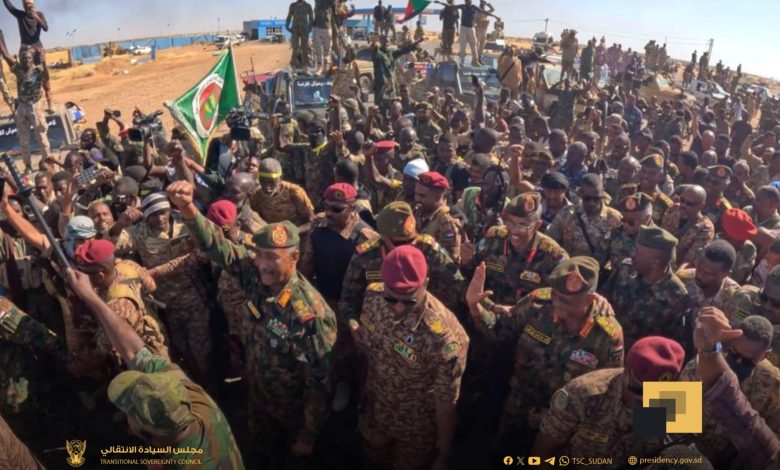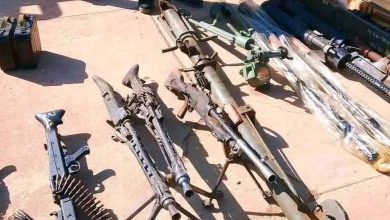Revealing the Secrets and Details of Breaking the Siege and Gaining Control of the Refinery

The Sudanese army made significant progress yesterday and today by breaking the siege that had lasted for more than a year and a half on its general headquarters in Khartoum, and today, it seized the oil refinery in Al-Jaili, north of Khartoum Bahri.
Strategic experts have described this development as a pivotal moment in the war between the army and the Rapid Support Forces, which has been ongoing for nearly two years.
According to “Al Jazeera Net,” the following report reveals the secrets and details of this major military development in the course of the war in Sudan.
5 PM, A Moment in History
At 5 PM Sudan time, a well-coordinated plan by the Sudanese army was completed, with forces coming from the north. The army units, including one from the Weapons Command in the Kadro area of Khartoum Bahri, another from the Wadi Sidna area north of Omdurman, and a third from the Engineering Corps in South Omdurman, joined forces with the Signal Corps in South Khartoum Bahri, linked to the general army headquarters through the Blue Nile Bridge.
This step, which turned aspirations into reality, took nearly a year and nine months to achieve. The achievement was celebrated with the presence of the Sudanese army’s chief of staff and senior military leaders. The significance of this step is that it broke the siege of the Sudanese army’s general headquarters, where members of the General Staff and senior commanders have been since the war broke out in mid-April 2023.
Rapid Support Forces’ Disbelief
Since rumors surfaced about the Sudanese armies merging in the city of Khartoum Bahri, the Rapid Support Forces remained silent for a while until a tweet from Bashar Tabiq, an advisor to the leader of the Rapid Support Forces, emerged. He described the merger as mere lies concocted by the remnants of the ousted Bashir regime. Meanwhile, other Rapid Support commanders challenged the Sudanese army on social media, demanding an official statement to confirm the news.
The army issued a brief statement announcing the merger of the forces as one of the key steps in their plan. A military source close to the Sudanese army noted that the brief statement was intended to leave space for a more detailed and comprehensive speech by the head of the Sovereignty Council, who would deliver it from his office at the general headquarters once security arrangements were finalized.
How Was the General Headquarters Besieged?
After the war broke out in mid-April 2023, on a hot Ramadan day, Rapid Support Forces commander Mohamed Hamdan Dagalo, known as Hemeti, sought a fatwa that would allow his men to break their fast. During this time, the Rapid Support Forces aggressively attacked the general headquarters of the army, aiming to capture General Abdel Fattah Al-Burhan or seize the headquarters to declare political changes through a swift coup.
However, this was prevented thanks to the steadfastness of the Republican Guard commanders, many of whom were killed that day. A retired officer told Al Jazeera Net that the concrete wall built by Al-Burhan around the army’s headquarters acted as an additional barrier, preventing the Rapid Support Forces from breaking into the general headquarters through intense fire and numerous equipped SUVs with anti-aircraft and anti-ground artillery. Since that day, the Rapid Support Forces have maintained a tight siege around the Sudanese army headquarters, which was only broken by Al-Burhan’s escape on August 24, 2023, through a complex operation carried out under the cover of darkness, the details of which the army has yet to disclose.
Plans for Breaking the Siege
According to military sources speaking to Al Jazeera Net, the Sudanese army developed several plans to break the siege, which had become a major concern. These included using drones to deliver medicine to those besieged, while food supplies were delivered via air drops.
Retired General Motassim Al-Hassan mentioned that this situation also put psychological pressure on the army’s leadership and complicated the rotation of exhausted troops, in addition to providing comprehensive medical care for the large force stationed at the general headquarters, which operated under extremely challenging conditions.
According to another military source, the first plan involved breaking the siege by using the Shambat Bridge across the Nile, north of Khartoum Bahri, and then advancing through western Bahri to the Mek Nimer Bridge across the Blue Nile, then crossing central Khartoum to reach the general headquarters from the east. However, this plan was discarded after parts of the Shambat Bridge were destroyed, making it unusable after a military operation in November 2023, where the army and Rapid Support Forces both denied responsibility, each accusing the other.
After dismissing this option, the second plan involved reaching the general headquarters via the Al-Nahda Bridge on the Blue Nile, linking Omdurman and Khartoum. In September, an advanced force reached the eastern side of this bridge in a broader operation targeting several major bridges in Khartoum, including Al-Nahda Bridge. This force advanced until it reached Khartoum Stadium, then contracted its defenses at the Hilton Hotel.
A field source told Al Jazeera Net that tall buildings and the presence of Rapid Support snipers slowed the army’s movement and allowed space for the third plan, which involved moving from the Halfaya Bridge on the northern Nile, linking Omdurman and Khartoum Bahri, with forces coming from the Wadi Sidna base north of Omdurman, merging with the forces from the Weapons Command at Kadro, and moving south to join the Signal Corps in Bahri, which was connected to the general headquarters via the Blue Nile Bridge near Khartoum University. This took place yesterday evening.
Final Arrangements: Al-Burhan Was Here
The head of the Sovereignty Council and Sudanese army commander-in-chief, Abdel Fattah Al-Burhan, oversaw the final plans for breaking the siege and held intense meetings with his military commanders in Wadi Sidna. He then visited military units in the Kadro area. Although he was supposed to stay in Omdurman throughout the past week, state management and the approval of the annual budget led him to return to Port Sudan, where the temporary government is based.
The Final Moments
According to sources close to the army commander, Al-Burhan returned to Omdurman early yesterday morning, Friday, to initiate the operation. He remained in the surrounding area, moving with member of the Sovereignty Council and his assistant, General Yasser Al-Atta, missing some of the advanced forces. After performing the Friday prayer in Sheikh Kabashi village, north of Khartoum, where residents were surprised by his visit, he quickly left following the prayer. Sources confirmed to Al Jazeera Net that Al-Burhan and his assistant visited the frontlines in Al-Jaili, where Sudan’s largest oil refinery is located, as well as the Kadro military base. Al-Burhan and General Yasser Al-Atta were present when the official announcement was made about the merger of the forces in southern Khartoum Bahri.
Weighing Two Objectives
According to two military sources speaking to Al Jazeera Net, the military leadership had to choose between entering the Khartoum refinery or breaking the siege of the army’s general headquarters. The priority was given to breaking the siege first, as it offered greater military and political returns. It was expected to help in controlling the refinery due to the army’s increased morale, which has been boosted by consecutive victories since September, according to strategic expert Dr. Osama Eidros. This was indeed the case, as the Rapid Support Forces withdrew from the refinery shortly after the announcement of the siege being broken. According to a senior military source, the army was cautious in entering the refinery, which was fully secured on Friday morning.
Multiple Routes, One Goal
The operation to break the siege began after the Sudanese army crossed the Halfaya Bridge in September. An internal security source said that three routes were identified: one to the west, parallel to the Nile, another east through the Kafouri and Kober areas to the Military Forces Bridge, and a third central route using Shahid Mohammed Hashim Mattar Street (previously called Al-Nahda), passing through the Shambat and Safiya areas to the Signal Corps in South Khartoum Bahri, then using the Blue Nile Bridge to reach the general headquarters.
The central route progressed faster than the others. Since Tuesday, a source from the Sudanese army said that an elite force raided seven Rapid Support positions in a swift operation, which brought the army to the south of the Khartoum Bahri railway station.
The army made significant advances by taking control of student dormitories near Ibrahim Malik in the area. On Thursday, the army took control of the dormitory building, coming close to other forces in the vicinity of the railway station.
Before the Clash…!!
The distance between the army forces coming from the north and south was about 2.5 kilometers. The source added that radio communication was established between the advancing forces from Omdurman and the Signal Corps headquarters. The zero hour was set after the Friday prayer. According to journalist Youssef Abdel-Mannan, the army avoided main routes to prevent snipers and used deceptive tactics. The merger was announced around 5 PM, first by military sources in the Sudanese army and then later as an official statement.
What Happens Next?
The merger of Sudanese army forces means the army now controls a supply chain stretching from Port Sudan to the city of Halfa in northern Sudan. Retired General Motassim Al-Hassan says this merger signals the beginning of the final battle, where the army must expand its control east and west within Khartoum Bahri. This will help tear apart what remains of the Rapid Support Forces, which now face difficult choices: either destruction or surrender.
Retired Air Force Captain and journalist Ali Mirghani views this as a classic “bridgehead” theory, where military operations begin by expelling the enemy from a small area and then expanding control. However, journalist Hafiz Kabeer, close to the Rapid Support Forces, denies these developments, claiming that the Rapid Support Forces are still present in Khartoum Bahri and will fight according to a pre-set strategy.
According to many experts, the breaking of the siege of the general headquarters and the seizure of the Al-Jaili refinery will leave a lasting impact on both the military and political operations in Sudan, with the army regaining control of central Khartoum and the battle intensifying around the presidential palace and major government institutions.
Source: Al Jazeera Net



